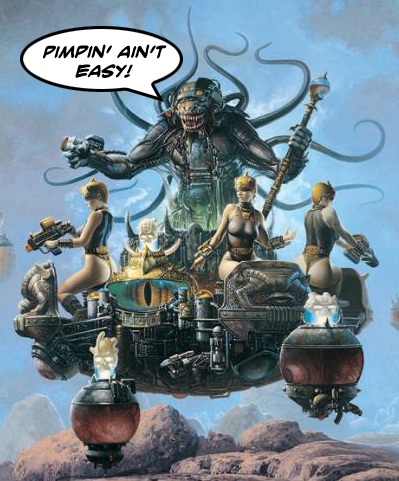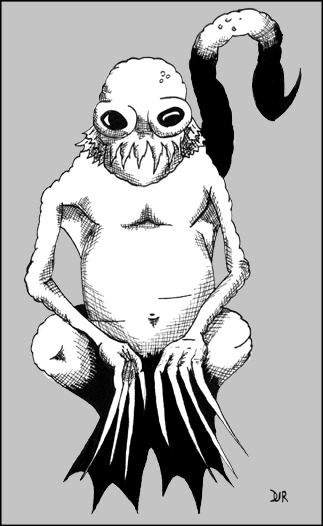 Now that I have the new Gamma World boxed set, I’ve been toying with the idea of using the rules to run a game set in the world of Rifts. In the way of research, I cracked open the Rifts books that I still had and took a stroll down memory lane. As I mentioned before, during the nineties I briefly cheated on my first rpg love (D&D) by having a brief but intense relationship with Rifts. My gaming group and I were a little more than halfway through our epic 2e Temple of Elemental Evil campaign, and realized that our original notion of rotating DMing duties each adventure was not going to pan out (I quote the back of the module, “hours of entertainment”). It was going to take all of high-school to finish (and it did). To keep things fresh, we occasionally took a break and tried out other settings (Dark Sun, Spelljammer, Al-Quadim), and games (TMNT, Top Secret). We were playing every week, so it was easy to find the time.
Now that I have the new Gamma World boxed set, I’ve been toying with the idea of using the rules to run a game set in the world of Rifts. In the way of research, I cracked open the Rifts books that I still had and took a stroll down memory lane. As I mentioned before, during the nineties I briefly cheated on my first rpg love (D&D) by having a brief but intense relationship with Rifts. My gaming group and I were a little more than halfway through our epic 2e Temple of Elemental Evil campaign, and realized that our original notion of rotating DMing duties each adventure was not going to pan out (I quote the back of the module, “hours of entertainment”). It was going to take all of high-school to finish (and it did). To keep things fresh, we occasionally took a break and tried out other settings (Dark Sun, Spelljammer, Al-Quadim), and games (TMNT, Top Secret). We were playing every week, so it was easy to find the time.
One of my friends wanted to try his hand at running a game and had just picked up Rifts. I was familiar with Palladium through TMNT, Heroes Unlimited and Robotech, so it wasn’t a stretch to try, but when I saw what character options the game had I was instantly sold. You can have a cyborg and a wizard in the same party? That’s cool… wait what’s that? YOU CAN BE A DRAGON?! After seeing that, I was convinced we would all play dragons, but my friend picked up the Rifts Conversion Book and Rifts Worldbook One: Vampire Kingdoms and there was so much cool crap it was overwhelming (there was one dragon in the party, but I ended up playing a vampire named Chopin whose coffin was hidden in his piano). We were hooked.
Fast forward to university and I was drifting farther and farther away from D&D. I kept my subscription to Dragon, but 2e was starting to feel stagnant. The only regular game I was running was Rifts, and even when the campaign was on hiatus the setting so intrigued me that I couldn’t help but roll up NPCs and create Rifts material (if you search the net you might find the very amateur font I made based on the diabolist’s runes – they even used it on the Palladium website for a while) in my spare time. Rifts is also the game that introduced my partner to role-playing, so for that I’ll always remember it fondly.
In spite of my enthusiasm, Rifts as a game system has a lot of problems. Reams have been written on the what, wherefore and why of this, but by grad school, the game’s warts were beginning to burn me out. It’s in vogue now to decry game balance as unnecessary (and perhaps 4e does fetishize it), but play Rifts for a few years and you’ll miss it. Maybe I’m an inadequate GM, but making interesting encounters that would challenge a party that included both a chiang-ku dragon temporal wizard and a plain old SDC operator was trying (in the end I encouraged SDC characters by giving them a ‘special item’ to start the game with – the longest running character, a mutant opossum, had Captain America’s shield). The fact that each new book seemed to have more powerful weapons, armor and character classes than the last just added to the balance issues (by the tenth book the glitter-boy power armor, the supposed final word in personal weaponry, was starting to look like a piece of junk).
As time wore on, I wasn’t spending my time creating anymore. Instead I was trying to think up house rules to make the game work. It got me down. Then something completely unrelated to Rifts happened that changed everything. D&D 3e was released. Suddenly, I remembered why D&D was my first love and what I had been missing all that time. I dropped Rifts like a hot potato and went running back to her. The new edition seemed to answer every problem that had plagued my Rifts campaigns: it had untrained skills, humans with mechanical advantages, and most importantly a single experience chart – because all the classes were worth playing.
Since then I’ve haven’t looked at the old Rifts books that much, so re-reading Erin Tarn’s gazetteer of North America was a blast, both as nostalgia and as inspiration (whether the Gamma World thing actually pans out or not). There was something else in the core Rifts book, tucked away at the back that I had completely forgotten about: a set of random tables for making supernatural monsters on the fly. As a GM I had absolutely loved these tables, not only were they fast and easy but they gave PC’s a good reason to take th e demon and faerie lore skill (each monster had a special weakness the skill could reveal). I was very disappointed to find out these tables were cut from the Rifts Ultimate Edition (don’t get me started on how disappointing this book is in general but the fact they would cut something useful like the monster generator and add in a page of rules for cyber knights to change the color of their psi-swords is a pretty clear illustration of why Ultimate Edition didn’t bring me back into the fold).
e demon and faerie lore skill (each monster had a special weakness the skill could reveal). I was very disappointed to find out these tables were cut from the Rifts Ultimate Edition (don’t get me started on how disappointing this book is in general but the fact they would cut something useful like the monster generator and add in a page of rules for cyber knights to change the color of their psi-swords is a pretty clear illustration of why Ultimate Edition didn’t bring me back into the fold).
Well, looking over the tables my dice started itching again and I couldn’t resist whipping up a supernatural predator. So after all the blather, I present the crunch: the grindylow.
The Grindylow
These dark and twisted faeries haunt bogs and lakes, preying on children and lone travelers who venture too close to their lairs. Although the grindylow prefer life underwater, they are amphibious and just as capable on land. Grindylow prefer dank and dismal surroundings and use their magic to befoul any waterway they occupy, earning them the enmity of nymphs and water sprites.
Grindylow are slow-witted and incapable of formulating complex plans. If food grows scarce they simply relocate, finding the quickest and easiest source of human flesh available. On Rifts earth, this is often in the sewer outside of a body chop shop, where they feast on the patrons’ discarded parts and the butchered remains of cyber-snatch victims.
The Grindylow – supernatural predator
Alignment: Diabolic
Attributes: IQ 6, ME 9, MA 4, PS 20, PP 18, PE 21, PB 2, Spd 12
M.D.C.: 80
Horror Factor: 13
P.P.E.: 40
Weight: 250 lbs (113 kg)
Size: 7 ft tall
Natural Abilities: swim 90%, track by sight 44%
Combat: Three attacks per melee (including one magical attack)
Damage: large retractable claws 3d6 M.D., prehensile tail with stinger 2d6 M.D.
Bonuses: +1 on initiative; +3 to strike; +2 to parry and dodge; +3 to save vs. poison and magic
Magic: Once per melee the grindylow can use either blind or spoil (this is a natural magical ability and not a spell, so it has no P.P.E. cost)
Psionics: None
Appearance: A squat gill-man with long, spindly arms and a prehensile tail
Average Life Span: 600 years
Habitat: Sewers, bogs, lakes and streams
Enemies: Water sprites and nymphs. The grindylow is fearful of well-armed groups.
Allies: Other creatures with a similar taste for flesh, and depraved individuals who use the grindylow as a man-eating ‘pet’.
Notes: The grindylow is vulnerable to weapons of silver, which inflict M.D. on the creature equivalent to the weapon’s S.D.C. damage.
Notes:
So after rolling its feeing habits (a solitary hunter who feeds on humans), and natural abilities (swimming), I figured the grindylow from English folklore fit the bill nicely (also the villains in the great China Mieville book, The Scar). That’s what I love about a set of random tables like this; many times the random results will point in a specific direction or remind you of something cool that’s been squatting in a dark corner of your brain that you haven’t thought about in a long time. Sure, you sometimes get something that doesn’t make a whole lot of sense (say a 25 ft tall predator that hunts in packs of 36 that breathes flames and is vulnerable to fire), but as long as the process isn’t too involved its easy to scrap it and start again (this time I got medium sized creatures who hunt in small packs, cast fireball every round and are vulnerable to symbols of goodness – instant hound of hell).
Tags: Blather, Original Art, Rifts
Pingback: Random Encounters: Gamma World and Rifts « Ménage à Monster
Pingback: Random Encounters: Grindylow « Ménage à Monster